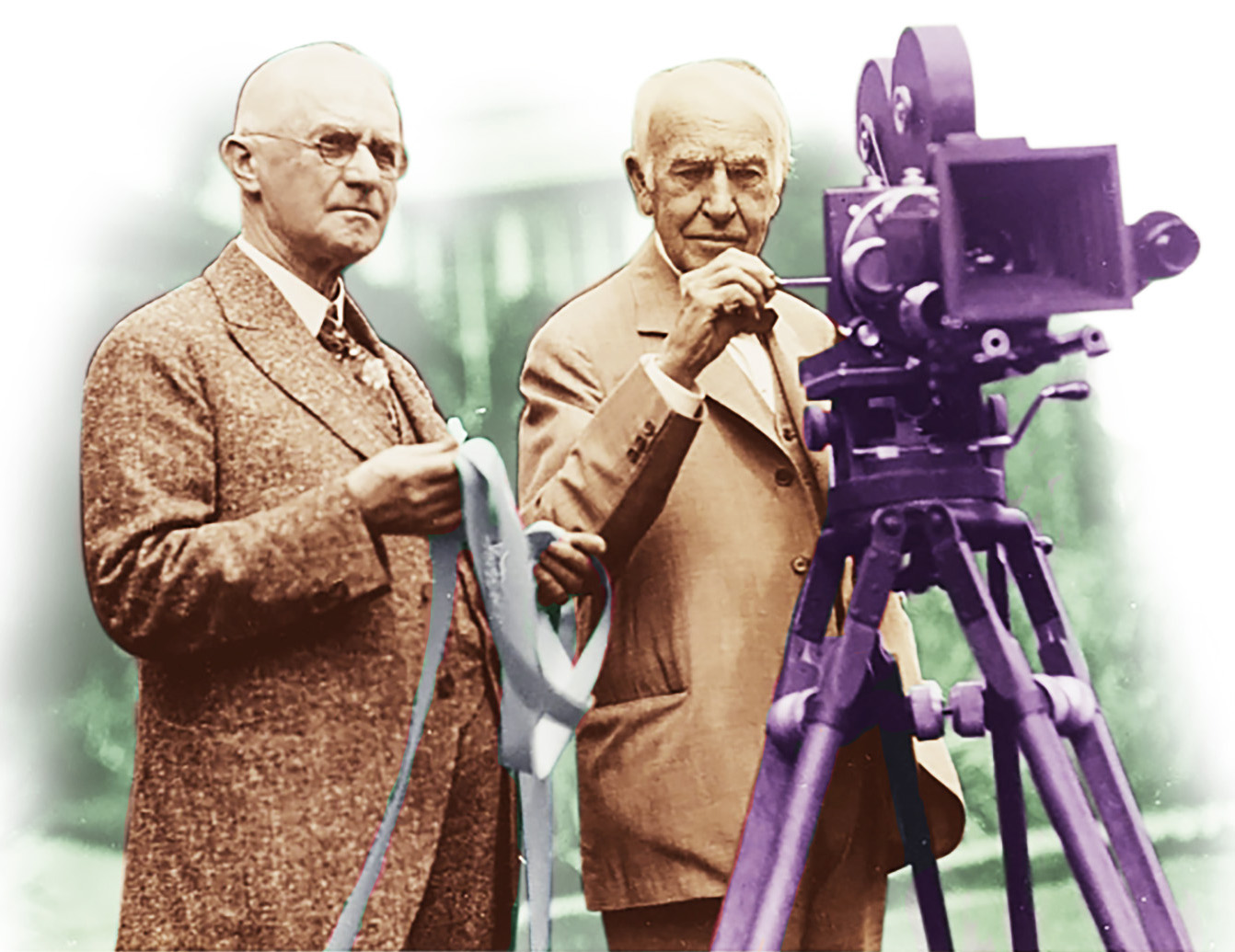
THOMAS EDISON
1847–1931
A prolific American inventor, Thomas Edison held a record number of patents and understood that having an idea was not enough—it had to be commercially viable. He set up the world’s first research facility to develop and manufacture groundbreaking inventions and initiated the birth of the electricity industry, changing society forever.
Born in Ohio, Thomas Alva Edison was the youngest of seven children. Finding it difficult to concentrate at school because of hearing difficulties, he was educated at home by his mother, a former teacher. With her encouragement, Edison developed into an avid reader who loved learning and experimentation.
At the age of 12, Edison started selling newspapers and confectionery on the Grand Trunk railroad line. This brought him into contact with the new technology of telegraphy, which was used to communicate daily news to the station office. Setting up a printing press in a baggage car, Edison started his first enterprise: turning these bulletins into a newspaper, which he sold alongside his other papers.
Communications industry
In 1863, Edison was taught to operate a telegraph by the father of a child he had saved from being struck by a train. Substituting for men who were fighting in the American Civil War, he spent the next five years moving from city to city as a telegrapher. Edison became increasingly interested in communications technology and electricity and began experimenting with improving the process of telegraphy.
Moving to New York in 1869, aged 22, Edison set up an electrical engineering company with two partners and developed a telegraph that could print changing stock prices on a ticker tape. Selling nearly 5,000 of these stock tickers between 1871 and 1874, he saved enough money to set up a small laboratory in Newark, New Jersey. Here, he focused on improving telegraphy equipment, developing receivers, automatic printers, and the quadruplex, which could transmit two signals in different directions through the same wire. Rivalry between the leading telegraph companies created such demand for his inventions that Edison was soon able to expand his business.
In 1876, he built a new research facility, which he described as his “invention factory,” in Menlo Park, New Jersey. With a machine shop, laboratories, and a staff of mechanics, carpenters, and engineers, it was the world’s first commercial research and development facility.
Within a year, Edison and his team had created the phonograph, which recorded and reproduced sound. Its invention brought Edison international fame and earned him the title “The Wizard of Menlo Park.”

Edison demonstrates his cine camera alongside George Eastman (left) in 1928. Eastman invented Kodacolor film, which was used in Edison’s camera to create the first films made for cinema.
“Genius is 1 percent inspiration and 99 percent perspiration.”
Thomas Edison, 1901
Power and light

Wanting to explore the potential of electricity, Edison formed The Edison Electric Light Company in 1878. By October 1879, he had created the first successful incandescent light bulb, lasting 13.5 hours and in May 1880 gave visitors a ride on the first electric railroad at Menlo Park. With mass production of electric lamps using his bulbs underway, Edison began to develop an electrical system that could provide economic light and power to cities as well as individuals. Setting up a series of companies to manufacture and operate the technology needed to supply electricity, Edison began to serve cities across the US and Europe.
With worldwide success, Edison rapidly outgrew Menlo Park. He moved first to New York and then to a new research facility in West Orange, New Jersey, which he directed from 1887 until his death in 1931. Building on previous research, this period saw the invention, production, and marketing of further innovatory products. An improved model of the phonograph, the cine camera, and an alkaline storage battery, among others, heralded the modern electric age, and Edison’s role in this power revolution.

Many of Edison’s most important innovations came to fruition at his “inventions factory” in Menlo Park, New Jersey. The facility used scientific research to explore ideas, with a view to creating practical products for the mass market.
AUGUSTE AND LOUIS LUMIERE

The Lumière brothers, Auguste and Louis, advanced cinema photography and formed an innovative photographic company.
Auguste (1862–1954) and Louis (1864–1948) helped their father in his small photographic plate business as teenagers. In 1881, Louis invented a new “dry plate” process for developing film. After seeing Edison’s cine camera, which could show images to only one viewer, the brothers developed their Cinématographe device, which could project film onto a screen. Lumière and Sons went on to become one of the world’s leading photographic companies, making numerous films, including the first newsreels and documentaries.
MILESTONES
FILES PATENT
Gets the first of his 1,093 successful US patents in 1868, at age 21. Later holds patents worldwide.
INVENTIONS HUB
Sets up the world’s first industrial research facility for invention in New Jersey in 1876.
RECORDS PRESIDENT
Captures the voice of US President Rutherford Birchard Hayes on his phonograph in 1877.
MAKES A MOVIE
Projects moving pictures using his Kinetograph, a cine camera, for the first time in 1896.
